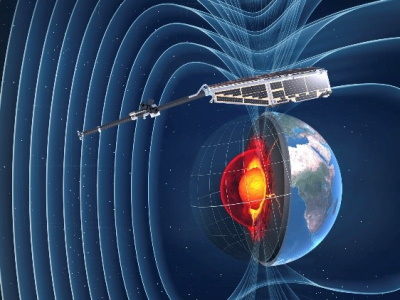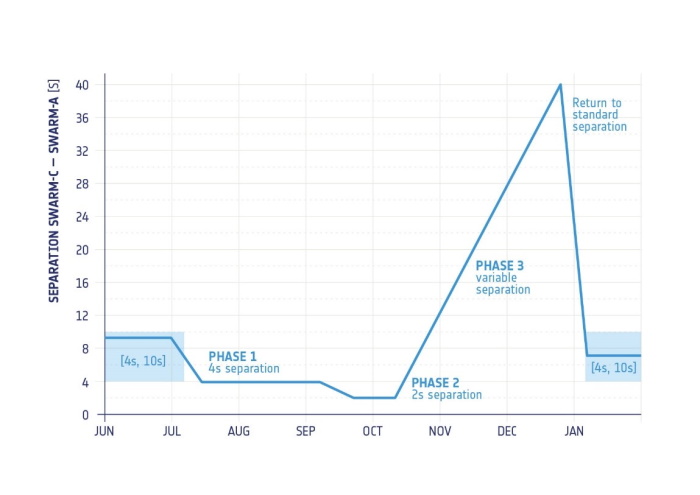- News
- Swarm’s orbital dance counter-...
Swarm’s orbital dance: counter-rotating and closer, for the benefit of science
16 Dec 2021

The Swarm mission is set to advance many areas of Earth science, by making key observations to untangle and model the many sources and strengths of our planet’s continuously changing magnetic field.
Swarm is ESA's first constellation mission for Earth Observation (EO). The mission consists of three identical satellites, named Alpha, Bravo and Charlie, launched on 22 November 2013, into a near-polar orbit.
The mission is dedicated to creating a highly detailed survey of Earth's geomagnetic field and its temporal evolution, as well as the electric field in the atmosphere, by using a satellite constellation that carries sophisticated magnetometers and other instruments: Vector Field Magnetomers (VFM), Absolute Scalar Magnetometers (ASM), Electrical Field Instruments (EFI) and Accelerometers (ACC).
Swarm-A and Swarm-C are called the lower pair satellites, i.e. the two satellites flying in tandem kept separated along-track by 4 to 10 seconds; while Swarm-B is flying higher (around 510 km instead of around 440 km of the lower pair). Their orbits are quasi-circular, with a low eccentricity.
Moreover, due to the different altitudes and relevant perturbations, the orbital planes are evolving differently – their angular separation is not fixed - and their rotation made it possible that one day the Swarm-B satellite would be on the same plane of the lower pair.

This phenomenon happened this year, in 2021. In the summer, the orbital planes of Swarm-B and Swarm-A / C were becoming closer and closer and were expected to achieve a counter-rotating configuration.
Following a request by the science community, which allowed to maximise even more the science return in the past months, the Swarm Spacecraft Operations Management Team has also been analysing possible variations of Swarm’s-A/C satellite separation—in terms of distance – to reduce and then increase the satellites separation and observe different phenomena at a lower spatial and temporal scale.
But what does all this mean?
The orbital plane’s natural evolution – given the fact of not being Sun-synchronous satellites - created this phenomenal science opportunity of Swarm-A/C and Swarm-B with the closest alignment in October. Considering that this plane-alignment only happens every 7-8 years, this opportunity had to be taken! In view of this, the tiny angular separation of the Swarm-A and Swarm-C orbital planes was also subject to correction in 2019: a small correction that reduced the difference of their planes close to zero by the time they would have met the Swarm-B plane!
In this alignment, Swarm-A and C were counter-rotating with respect to Swarm-B, meaning rotating in an almost identical plane, the closest alignment limited to a few days. The opportunity, however, did not last only a few days, since the closer angular separation during previous and following months will continue to offer exciting scientific opportunities.
From 15 June to 9 September, the separation of Swarm-A and C was kept via several orbital manoeuvres to 4 seconds - meaning that Swarm-A was following Swarm-C after literally only 4 seconds, while between 23 September to 5 October, it was changed to only 2 seconds, corresponding to only around 15 km along the orbit.
Data from these very close orbits will help separate temporal from spatial phenomenon in our near Earth Space.
The final phase of the campaign, called “variable separation”, implied an increase of the Swarm-A/C separation, from 2 seconds to around 40 seconds, until mid-December 2021, to tackle different phenomena, in particular those co-rotating with Earth: the satellite’s separation has been designed such as the observation of these will be possible by all Swarm spacecraft, with a small temporal difference.
To return to the original configuration however, Swarm’s lower pair must re-acquire an along-track separation between 4 and 10 seconds. This will be achieved with a last orbital drift to be started in mid-December, which will bring them "together" again by mid-January.

All of the above-mentioned "campaigns" required around 20 orbital manoeuvres to establish and then keep the necessary separation, providing the science community with the best and as-far-as possible constant conditions to acquire science measurements.
During the 2 seconds separation phase, particular care was placed to make sure proper additional satellite monitoring measures were taken, to ensure that anomalies would be acted upon very quickly and without any impact to the constellation’s safety.
In particular, the distance between Swarm-A and Swarm-C was the closest ever—except during LEOP (Launch and Early orbit phase, i.e. first week after launch) and the phases of orbit acquisition, which occur early on in the mission.
That is why the risk of a satellite crossover (a swap between trailing and leading spacecraft), given the closer distance, in case an anomaly on-board had influenced the orbit, had to be mitigated with different measures. Additional ground station passes and tighter monitoring were put into place, to ensure a robust risk mitigation.
The science objective of having these closer orbits is to address magnetosphere-ionosphere-thermosphere environment and their coupling, which at this closer distances and times allow studying structures on our near Earth space at a variety of scales, including the smallest, and by having all three spacecrafts passing over the same structure in close succession we can also distinguish between spatial and temporal variations.
Anja Stromme, ESA’s Swarm Mission Manager, states, “This has been a very exciting fall really utilising the Swarm mission to its fullest by carefully planning and executing the variety of orbital configuration we have put our three spacecrafts into, and the whole science community is now working on the data, hopefully revealing new and ground breaking science in the months and years to come.”
ESA’s Swarm Spacecraft Operations Manager, Giuseppe Albini, adds, “The planning and execution of all manoeuvres was possible thanks to the coordination of all parties involved, from the Management to the Flight Operations Segment and especially the Flight Dynamics group at ESOC, not to mention all ground teams handling and processing the science data.
“In particular, an extensive analysis before the campaign allowed to plan it taking into account all safety aspects, considering all the scenarios that could affect it”, concluded Albini.